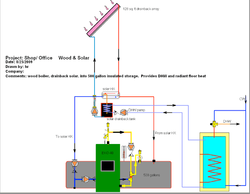On a few recent posts the positioning of the boiler circulator and air elimination devices have been brought up. I'm in the process of adding storage to my system and while I'm working on that if I need to change a few things I would do it then. I already have a partial list......
Boiler circulator position. If you are using a mixing valve "termovar / danfoss" don't you want the circulator closest to the boiler on the return line with the mixing valve before it. So, you are pulling the water through the mixing valve and pushing the tempered water into the boiler ? The critical part being that the mixing valve preforms best when the water is pulled through it ?
Air removal. There was a excellent post on this. It described the reason for the location of the scoop / spirovent ( and expansion tank ) to be located prior to the return circulator. The reason was to do with the pressure drop in the line prior the the circulator pump helped release the dissolved oxygen "like taking the top of a soda bottle". This makes perfect sense.
Here's the problem that's not where it's shown on the Tarm instructions nor was that where it was put on my near boiler piping lay out supplied by a third party. Both these layouts have the scoop on the supply (hot out) side of the boiler. Do they do this because of the mixing valve on the return, unlike a generic oil system ?
Boiler circulator position. If you are using a mixing valve "termovar / danfoss" don't you want the circulator closest to the boiler on the return line with the mixing valve before it. So, you are pulling the water through the mixing valve and pushing the tempered water into the boiler ? The critical part being that the mixing valve preforms best when the water is pulled through it ?
Air removal. There was a excellent post on this. It described the reason for the location of the scoop / spirovent ( and expansion tank ) to be located prior to the return circulator. The reason was to do with the pressure drop in the line prior the the circulator pump helped release the dissolved oxygen "like taking the top of a soda bottle". This makes perfect sense.
Here's the problem that's not where it's shown on the Tarm instructions nor was that where it was put on my near boiler piping lay out supplied by a third party. Both these layouts have the scoop on the supply (hot out) side of the boiler. Do they do this because of the mixing valve on the return, unlike a generic oil system ?



